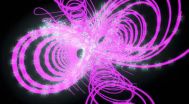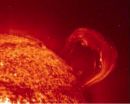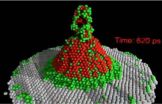Getting to know the sun advances fusion research
Coaxial helicity injection could make fusion reactors cheaper
2010-11-09
(Press-News.org) Researchers at the Princeton Plasma Physics Laboratory have successfully used Coaxial Helicity Injection (CHI) to generate plasma current and couple it to a conventional current generation method at the National Spherical Torus Experiment (NSTX) fusion experiment. After coupling, the combined process generated 1 million amperes of current using 40 percent less energy than needed to generate this current using the conventional means by itself, thus demonstrating that a high-quality initial magnetic configuration was produced by CHI.
Plasma confinement devices based on the tokamak concept rely on a solenoid through the center of the device to generate the initial current. Because the solenoid is used as an electrical transformer, its pulse length is limited in duration and it cannot sustain the initial current indefinitely in a steady-state reactor. Thus a method to eliminate the solenoid would remove a large component from the center of the tokamak, making the device simpler and less expensive. This allows the freed space in the center to be used in optimizing the device, making the tokamak more efficient by producing a magnetic configuration similar to that in a spherical tokamak.
CHI generates plasma currents by producing a magnetic bubble using magnetic reconnection. This is analogous to producing a soap bubble by blowing air through a ring dipped in soap solution. During CHI, currents are driven along magnetic filaments so that the resulting magnetic forces overcome the magnetic filament tension and cause the magnetic surface to stretch into the tokamak vessel. The figure below is a sequence of visible camera images that shows the bubble being generated on the lower part of NSTX and expanding to fill the entire vessel volume. Solar flares on the surface of the sun erupt and also reconnect through the process of magnetic reconnection.
After this bubble has been created in NSTX it carries a current of more than 250 thousand amperes, which is 100 times more than the seed current used to initiate the discharge. As a result of this very high current multiplication factor the process is efficient and consumes less than one Joule of stored energy to generate 10 amperes of current. The CHI method has been studied in the smaller Helicity Injected Tokamak (HIT-II) at the University of Washington in which the current multiplication factor was six. NSTX is thirty times larger in volume, and researchers have found the process to be much more efficient on NSTX, indicating that the method scales well to future larger machines.
In a steady-state reactor this initial current would be sustained by injecting high-energy particles. These particles would produce more current if the plasma density is small. For easier control of high-performance plasma, it is necessary that the distribution of the plasma current is preferentially driven near the outer edges of the magnetic configuration. The recent CHI discharges on NSTX have also generated the start-up current with these desired features needed for steady-state operation.
These exciting new results, combined with the capability of CHI to produce a large amount of current at high efficiency in larger machines, bodes well for the application of this new method in future tokamaks and spherical tokamaks. These results will be presented in an invited talk at the American Physical Society, Division of Plasma Physics 52nd annual meeting on November 8-12 in Chicago.
INFORMATION: END
ELSE PRESS RELEASES FROM THIS DATE:
2010-11-09
Fusion plasmas in the laboratory typically reach 100 million degrees. These high temperatures are required to ignite the hydrogen plasma and maintain the fusion burn by the production of high-energy alpha particles. One challenge for a fusion reactor is how to contain the alpha particles in the vessel long enough for the particles to efficiently heat the hydrogen plasma. One way that these alpha particles can escape the fusion chamber prematurely is by exciting high frequency Alfvén waves and riding these waves to the vessel walls, like a surfer rides a wave to the beach.
While ...
2010-11-09
When physicists probe the mysteries of plasma, the fourth state of matter, they often discover phenomena of striking beauty. Much as when the Hubble Space Telescope sent back vivid images from space of ionized gas clouds (an interstellar plasma!), new 3D images of shear Alfvén waves are delighting both scientists and a new generation of science enthusiasts.
Plasmas support a large variety of waves. Some of these are familiar, such as light and sound waves, but a great many exist nowhere else. One of the fundamental waves in magnetized plasma is the shear Alfvén wave, ...
2010-11-09
Just like an electrical switch allows the flow of electricity into electrical circuits, relativistic transparency in plasma can act like a fast optical switch allowing the flow of light through otherwise opaque plasma. Modern day lasers, such as the Trident laser in Los Alamos National Laboratory delivers a 200 terawatt power pulse (roughly 400 times the average electrical consumption of the United States) in half a trillionth of a second (picosecond) time. As shown in Fig. 1, when the laser power reaches a threshold limit, relativistic transparency in plasma turns the ...
2010-11-09
The Sun sporadically expels trillions of tons of million-degree hydrogen gas in explosions called coronal mass ejections (CMEs). Such clouds—an example is shown in Figure 1a—are enormous in size (spanning millions of miles) and are made up of magnetized plasma gases, so hot that hydrogen atoms are ionized. CMEs are rapidly accelerated by magnetic forces to speeds of hundreds of kilometers per second to upwards of 2,000 kilometers per second in several tens of minutes. CMEs are closely related to solar flares and, when they impinge on the Earth, can trigger spectacular auroral ...
2010-11-09
Physicists working on the National Spherical Torus Experiment (NSTX) at the Princeton Plasma Physics Laboratory are now one step closer to solving one of the grand challenges of magnetic fusion research—how to reduce the effect that the hot plasma has on fusion machine walls (or how to tame the plasma-material interface). Some heat from the hot plasma core of a fusion energy device escapes the plasma and can interact with reactor vessel walls. This not only erodes the walls and other components, but also contaminates the plasma—all challenges for practical fusion. One method ...
2010-11-09
Whenever two pieces of metal at different voltages are brought near each other, as when an appliance is plugged into a live socket, there is a chance there will be an arc between them. Most of the arcs people see are a breakdown of the gas between the metal surfaces, but this type of breakdown can also occur in a vacuum. This vacuum breakdown, which until recently has not been well understood, has implications for applications from particle accelerators to fusion reactors.
As part of an effort to understand the maximum accelerating field in particle accelerators, scientists ...
2010-11-09
The outlook for patients with breast cancer is determined in part by whether or not their tumor has spread to other sites in the body. A team of researchers, led by Roman Perez-Fernandez and colleagues, at the University of Santiago de Compostela, Spain, has now identified in a subset of patients with breast cancer, a marker associated with the occurrence of tumors at distant sites; a finding that they hope might help predict a patient's outlook more accurately. Specifically, the team found that in patients with breast cancer that was accompanied by the presence of tumor ...
2010-11-09
EDITOR'S PICK: PIT(-1)ting good and bad outcomes against each other in breast cancer
The outlook for patients with breast cancer is determined in part by whether or not their tumor has spread to other sites in the body. A team of researchers, led by Roman Perez-Fernandez and colleagues, at the University of Santiago de Compostela, Spain, has now identified in a subset of patients with breast cancer, a marker associated with the occurrence of tumors at distant sites; a finding that they hope might help predict a patient's outlook more accurately. Specifically, the team ...
2010-11-09
Females are more likely to have an unprotected first sexual encounter than their male counterparts.
This finding was a surprise to Nicole Weller, an Arizona State University graduate student working toward her doctoral degree in sociology, who presented preliminary findings on research she is conducting on the relationship between early sex education and the onset of sexual activity at the 138th annual American Public Health Association Social Justice Meeting and Expo in Denver on Monday, Nov. 8. Weller is a student in the School of Social and Family Dynamics in the College ...
2010-11-09
Using proton pump inhibitors (PPIs) and antiplatelet drugs (thienopyridines) together is an appropriate way of treating patients with cardiovascular (CV) disease who are at high risk of upper gastrointestinal (GI) bleeds, despite recent concerns about an adverse interaction between these two types of drugs, according to an Expert Consensus Document released jointly today by the American College of Cardiology Foundation (ACCF), the American College of Gastroenterology (ACG), and the American Heart Association (AHA).
The potential benefits of antiplatelet therapy for patients ...
LAST 30 PRESS RELEASES:
[Press-News.org] Getting to know the sun advances fusion research
Coaxial helicity injection could make fusion reactors cheaper



